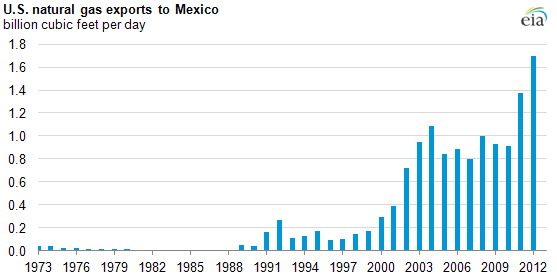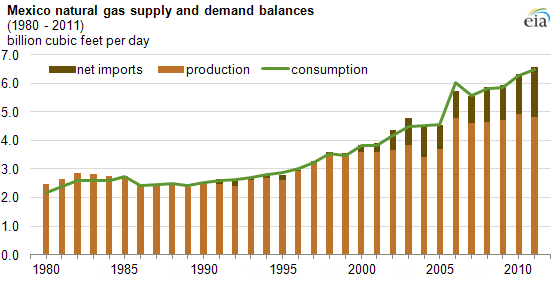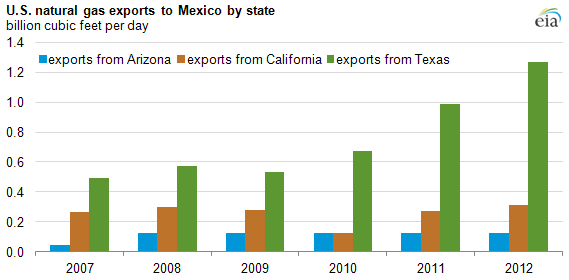
U.S. natural gas exports to Mexico reach record high in 2012

U.S. natural gas exports to Mexico grew by 24% to 1.69 billion cubic feet per day (Bcf/d) in 2012, the highest level since the data collection began in 1973. With imports now accounting for over 30% of its total supply, Mexico's natural gas use is also at its highest level ever.

Natural gas consumption is rising faster in Mexico than natural gas production, and as a result, Mexico is relying more on natural gas imports from the United States. Between 2007 and 2011, natural gas consumption in Mexico rose 4% per year on average, while average annual natural gas production climbed only 1.2%. Growing demand in the industrial sector drove the increases in natural gas consumption in Mexico to a record-high level in 2011, according to Petróleos Mexicanos (PEMEX)—the state-run oil and natural gas producer in Mexico.
Before 2006, almost all of Mexico's natural gas imports came from the United States. More recently, Mexico has diversified its supply sources by importing liquefied natural gas from Nigeria, Qatar, Indonesia, Peru, and Yemen, although the vast majority of their natural gas imports continue to come from the United States.

Pipeline shipments from Texas to Mexico between 2009 and 2012 rose 34% on average per year to 1.3 Bcf/d, which was about 75% of the U.S. natural gas exports to Mexico in 2012. Most of the U.S. exports to Mexico departed the country from Hidalgo County in southwest Texas, where the supplies were likely coming from the Eagle Ford play.

Several U.S. pipeline export projects that could support additional natural gas exports to Mexico have been announced. According to company announcements, these projects are expected to be completed by the end of 2014 and, if they are all built, could add up to 3.5 Bcf/d of additional export capacity to Mexico, doubling existing capacity.
This additional capacity would serve an expected increase in natural gas demand from Mexico's electric power sector. Mexico plans to add about 28 gigawatts of new electric generating capacity between 2012 and 2027, mostly in northern Mexico, according to Comisión Federal de Electricidad (CFE)—Mexico's state-run electricity provider. CFE estimates that this could raise natural gas needs for power generation by 5.1 Bcf/d. This level of growth would likely require increased natural gas imports from the United States.